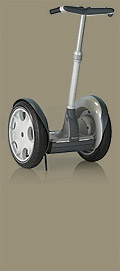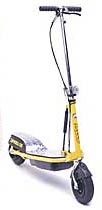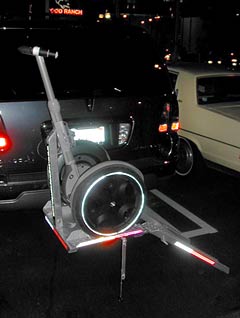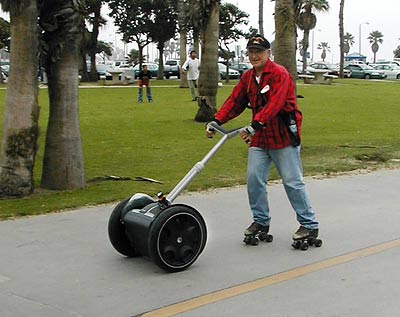|
...possibly the coolest way to travel modest distances... |
||
|
Page: |
Q! Won't it make you fat? A. Only if you eat it in one sitting. But I think you meant "all that lost exercise," eh? Bicycling is a better exercise than most, and it does get you farther, faster than an HT. So if travel = exercise = bicycling = weight loss for you, then the HT is not that part of your diet. But just because there is an alternative mode of transportation that does cause more exercise doesn't mean the issue is laid to rest. If travel = exercise = weight loss were the universal weight control premise, then how come we don't simply walk to the next city every time we go? As my art teacher used to say, "You've got to draw the line somewhere." I live about 1.5 miles from my city center of Glendale, California, on a hill, overlooking the town. I've never walked to it because I have a car that works perfectly fine, thanks. But in doing so, I add pollution to the LA basin, even though the car is rated for extraordinary non-polluting efficiency. So the choice is not weight control, but a combination of fun, responsibility and practicality. One Early HT Adopter, Phillip Torrone, has been using the HT for months now, and has actually lost weight (at about 6 lbs per month, he will disappear completely some time in 2006). His commute is over hill and dale for 7+ miles/day, and he's reduced the world of one car's worth of pollution, saving money at the same time. He has converted his commute sit-time to commute stand-up time. I think that the standing/navigating/weight adjusting work-out of HT travel is not zero exercise. Water skiing (to pose an obvious unfair example) is not zero exercise, but you aren't walking or pedaling there, either. As you navigate on an HT, you are actively doing all the exercise of walking minus the part about lifting the legs with each step. You are doing less work than a surfer, but much more than a person simply standing in one spot. If you have ever had a stand-up job, you know how non-trivial that effort is, too.
I passed a golf course the other day on my way to lunch. One of the cart-driving golfers on a green looked up and said, "Golf cart of the future?" to his buddies. Now all we need is a club with interchangeable heads to reduce the carry weight... Will there be a bike carrier for the HT? Probably not. But there will be many HT owners who have--and use--both. Already people are attaching HT carriers on cars. The military is engaged in trials of the HT for various uses. Some, like the ability to get a HazMat or Bomb Squad person into position without the usual long walk to the site of focus, involve a trailer full of gear hitched to the HT. |
 |
 |
Q! Isn't this just a fancy electric scooter? A. Moving becomes electric. Electric scooters have been around for a long time. Small wheels + need for active balance by you + traditionally flaky steering. They are low tech, low touch and often dangerous in their design*. The HT is an intellectual leap past these limitations, and an opening into new potentials. It is engineered to be compatible with foot traffic with its intuitive move/stop operating system. It's more systems-redundant, fault-tolerant, safety-aware than anything you have traveled in/on, including your highly evolved car (pound for pound). And it is scooter-fun. Want your mail faster? Tell the Post Office to get them. Never mind, it's been done. Want your police to be ready for the next Slow Speed Chase? Get them to... Oops. Been done too. Want to zoom around the city center safely and with the same aplomb of walking? Give it a try. But, yes. It is a great deal fancier than a scooter. Steering is intentionally not connected to the twist of the handlebars, and safety features warn you of imposed speed and performance limits. Balance is active from the machine, so you can spend zero effort balancing while standing still. Double-redundant engineering provides fail-safe operation of critical systems, and the ride is extremely smooth. Does it scoot? Yes, but to call it a "scooter" is like calling an airplane a "kite." * Straight, short handlebars, small wheels, low stopping power, exposed metal "collision surfaces," sharp edges... |
 |
|
Q! Whadda
ya mean it doesn't have any brakes? A. I mean it doesn't have your father's Oldsmobile's brakes. Instead, it has Super Brakes. Disentangle the notion of wheel-locking brakes--a thing cars have--from the notion of fast-stopping, which is what the HTs have. People tend to lock into what they've been aware of in the past as the ONE thing that fits their understanding of it in the present. I have tried several ways to impart the idea to folks, and I see that getting into an involved discussion of regerative braking, dynamic braking, the motor becomes its own brake, and so on, is not initially helpful. The core Idea:
I'll use Power Assist mode as a teaching aid. In Power Assist mode, you use the motors for climbing the HT up stairs or to move it without being on it. The HT becomes a motor with wheels. But you can activate the motors using the steering collar by proportional degrees and feel their strength directly. The motors are very powerful, delivering a combined peak effort of 4 horsepower. Three of those horsepower are a reserve to keep you out of trouble, should you become unbalanced, or need it momentarily to stop. Still, the one horsepower you usually access is considerable. Try a tug of war with a horse. A: The
brakes are huge because they're the full power of the motor itself.
The whole wheel becomes the brake. In a sense, it's a four-horsepower
brake. E: The one thing they won't do is lock up on you because they actively DRAIN your momentum out of your forward motion, and in order to do that, the stopping system needs the wheels to turn and for you to maintain balance. Braking System: The details are as exotic as the balance system. And the two are connected. When you crank a generator, it's hard to do if there is a load on it. You have to work at it, and the greater the load, the harder it gets. The huge batteries underneath the HT are a huge electrical load when the motors become generators--which is exactly what they do when the HT is asked to stop. The motors become so hard to turn that they pull the energy out of your forward motion very quickly, turn it into electricity and feed it to the hungry batteries. Not only that, but this thing applies its brakes so perfectly that you don't lose balance when it is happening. Your body and the machine brake to a safe, fast stop (to coin a phrase) as a single unit, fully balanced. It feels so smooth and intuitive that you have no sense of the sophisticated power management system under your feet. Complexity has been converted into magic, of a sort, without your need to think about it. The Physics: The kinetic energy of your forward motion gets translated into power which is generated through the motors and much of it is stored in the batteries as chemical potential energy along with some energy that is lost as low-grade heat. You not only stop, but you get some of your go back. The heat is microscopic, compared to the heat of disk brakes, which convert all forward motion into wasted heat. The cool thing about the whole system is that it feels seamless. Going and stopping use the same "motor," but half the time, it's really acting as a high-efficiency generator. |
||
|
|
||
 The
first day you glide around town for an hour or more, you WILL
feel the exercise ache by the next day. You will likely feel
it in your calves and in your waist. And what part of the body
are people lamenting the most? A waist is a terrible thing to
mind.
The
first day you glide around town for an hour or more, you WILL
feel the exercise ache by the next day. You will likely feel
it in your calves and in your waist. And what part of the body
are people lamenting the most? A waist is a terrible thing to
mind.
 Let's start from the conceptually fixed idea (stopping
power) and go to the movable (the actual details of the system)
to build an understanding of "braking" as it applies
to the Segway.
Let's start from the conceptually fixed idea (stopping
power) and go to the movable (the actual details of the system)
to build an understanding of "braking" as it applies
to the Segway.